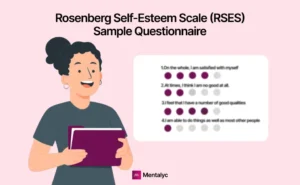Therapists see the impact of depression in their work every day. It doesn’t discriminate—it affects people of all ages, cultures, and socioeconomic backgrounds. Depression often starts as a subtle but relentless shadow, clouding the ability to function or feel joy, leaving clients struggling to explain their symptoms or understand their own experiences. This can make the therapeutic process challenging, especially in the initial stages of assessment and treatment planning.
This is where tools like the Beck Depression Inventory (BDI) become essential. The BDI is designed specifically to help professionals like you quantify and assess the severity of depressive symptoms. It offers clarity in the complexity of this condition. It empowers you to uncover the details of your clients’ experiences, leading to better understanding and opening the door to more tailored, effective interventions. The BDI has been trusted for years: it supports therapists in transforming lives, one assessment at a time.
What is the Beck Depression Inventory (BDI)?
The Beck Depression Inventory (BDI) is a revolutionary tool that revolutionized how we understand and measure depression. It was first introduced in 1961 by Dr. Aaron T. Beck, a pioneer in cognitive therapy, the BDI was born out of his groundbreaking theory that depression stems from negative thought patterns and distorted beliefs. Unlike earlier tools that relied heavily on clinician observations, the BDI empowered individuals to self-report their own symptoms, providing a more personal and accurate view of their mental state [1].
With its 21 items, the BDI asks individuals to rate how specific symptoms of depression—such as sadness, hopelessness, or loss of energy—have affected them over the past two weeks. This approach not only captures the presence of depressive symptoms but also quantifies their severity, making it an invaluable tool for clinical use.
Over time, the BDI has evolved to stay up-to-date. In 1996, the BDI-II was introduced to align with the DSM-IV criteria for depression diagnosis. This revision wasn’t just a cosmetic upgrade; it reflected significant advancements in our understanding of depression. For example, the BDI-II excluded items related to weight loss or physical symptoms linked to medical conditions, making sure that the tool focused only on psychological and behavioral indicators of depression [2]. These changes improved the tool’s accuracy and relevance, making it adaptable to diverse populations and clinical needs.
Today, the BDI is regarded as a gold standard in mental health assessment, a testament to Dr. Beck’s vision and its enduring impact. Whether used by clinicians, researchers, or individuals, it continues to play a vital role on one of the most pressing mental health challenges of our time.
How Does the BDI Work?
Structure and Format
The BDI-II consists of 21 carefully designed items, each representing a symptom commonly associated with depression. Symptoms range from emotional challenges like sadness and irritability to physical manifestations like fatigue and changes in appetite. Respondents rate how intensely they have experienced the symptom over the past two weeks, using a 4-point scale from 0 (no symptom) to 3 (severe symptom). This straightforward yet comprehensive design captures the varied ways in which depression can manifest, making it an invaluable tool for tracking symptoms across time and contexts [3].
Scoring
The BDI-II offers clear thresholds to interpret scores:
- 0–13: Minimal depression
- 14–19: Mild depression
- 20–28: Moderate depression
- 29–63: Severe depression
This framework not only provides a snapshot of an individual’s depression severity but also serves as a guide for clinicians to tailor their interventions accordingly. The higher the score, the greater the need for targeted therapeutic strategies. Its simplicity makes sure it can be used quickly and effectively in diverse settings.
Time Required
One of the BDI-II’s key strengths is its brevity. It takes only 5–10 minutes to complete, so it fits seamlessly into therapy sessions, research protocols, or even self-assessments. Its quick administration makes it particularly useful for monitoring changes over time, such as evaluating the impact of treatment or identifying the progression of symptoms.
What it Measures
The Beck Depression Inventory-II (BDI-II) evaluates depression through two key dimensions: cognitive-affective and somatic symptoms [4]. The cognitive-affective aspect focuses on emotional and mental experiences, such as feelings of sadness, guilt, worthlessness, and self-criticism. It also identifies agitation and suicidal thoughts, offering a clear picture of how depression affects a person’s inner world and thought patterns.
The somatic dimension examines the physical side of depression, assessing issues like sleep disturbances, changes in appetite, fatigue, and trouble concentrating. These symptoms reveal how depression impacts daily life and physical well-being, offering a holistic understanding of the condition. Together, these dimensions ensure the BDI-II provides a comprehensive assessment.
By capturing both mental and physical symptoms, the BDI-II helps therapists tailor treatment plans to meet each client’s unique needs. Whether the focus is on challenging negative thought patterns or addressing physical symptoms, this tool empowers therapists to provide care that truly supports recovery.
Uses of the Beck Depression Inventory (BDI)
These are some of the main uses of the Beck Depression Inventory (BDI), highlighting its versatility in both clinical practice and research settings [1].
In Clinical Settings
1. Screening for Depression
The BDI is often used as a preliminary screening tool to identify the presence and severity of depressive symptoms. It is particularly effective in detecting depression in individuals who present with vague psychological or somatic complaints, helping clinicians recognize underlying issues that might otherwise go unnoticed
2. Monitoring Symptom Progression
Depression is a dynamic condition, with symptoms that can vary over time. The BDI allows therapists to track these changes systematically. By administering the BDI periodically, clinicians can monitor changes in symptoms and make data-driven adjustments to treatment plans. For example, a significant decrease in BDI scores over a few sessions may indicate that a particular therapeutic approach is working effectively.
3. Evaluating Treatment Effectiveness
The BDI is a valuable tool for assessing the impact of therapeutic interventions. By comparing pre- and post-treatment scores, mental health professionals can decide whether their strategies—such as cognitive-behavioral therapy (CBT), medication, or other methods—are achieving the desired results. This feature is particularly useful in multidisciplinary approaches where multiple treatments are being applied simultaneously.
4. Guiding Clinical Diagnoses
While the BDI is not a diagnostic tool on its own, it plays a valuable supportive role in the diagnostic process. When used in combination with clinical interviews and other assessments, it provides quantitative data that enhance the clinician’s understanding of the client’s mental health status.
In Research
1. Epidemiological Studies
Researchers have used the BDI to investigate the prevalence of depression in different demographics, including specific age groups, cultures, and medical conditions. For example, studies have explored how chronic pain, coronary artery disease, or other health challenges correlate with depressive symptoms
2. Clinical Trials
In clinical trials testing antidepressants or therapeutic interventions, the BDI serves as a reliable measure for gauging treatment efficacy. Its high sensitivity to changes in depressive symptoms makes it a preferred choice for documenting progress over time
3. Cross-Cultural Research
With translations in multiple languages, the BDI is frequently used in cross-cultural studies. Researchers examine how depression manifests in different populations and assess whether cultural factors influence the expression or perception of depressive symptoms. This has contributed to a broader, more inclusive understanding of depression as a global phenomenon.
Beyond Traditional Uses
In addition to its established applications, the BDI is increasingly being integrated into innovative mental health practices. For example, some digital mental health platforms now include the BDI as part of their assessment process, combining its reliability with the convenience of technology. Additionally, occupational health programs have adopted the BDI to screen for depression in workplace settings, recognizing its role in fostering employee well-being and productivity.
The BDI’s versatility, adaptability, and scientific backing make it one of the most effective tools for understanding depression. Its applications span clinical care, academic research, and personal mental health journeys, ensuring its continued relevance in addressing one of the most pressing mental health challenges of our time.
Reliability and Validity
The Beck Depression Inventory-II (BDI-II) stands as a cornerstone in the assessment of depression, renowned for its refined psychometric properties. Decades of rigorous research and thoughtful revisions have sculpted this tool into a reliable and precise measure of depressive symptoms. By aligning its content with DSM-IV criteria for major depressive disorders, the BDI-II ensures that it captures the full spectrum of symptoms with unparalleled accuracy.
One of the BDI-II’s most compelling strengths is its internal consistency, boasting coefficient alphas of 0.91 for psychiatric outpatients and 0.93 for college students. This demonstrates the seamless alignment of its items in measuring the essence of depression. Moreover, its concurrent validity shines, with strong correlations to other gold-standard measures like the Minnesota Multiphasic Personality Inventory-D (r = 0.77). Its criterion validity is equally impressive, showing a robust relationship with the Hamilton Depression Rating Scale (r = 0.71) [3].
The BDI-II’s ability to combine precision with practicality makes it a trusted ally for clinicians and researchers alike. Whether used to track subtle shifts in symptom severity or to anchor studies in reliable data, the BDI-II continues to set the bar high in depression assessment. Its legacy as a scientifically sound and user-friendly tool underscores its role as an indispensable resource in the mental health field.
Limitations
Despite its strengths, the BDI-II is not without limitations. It is important to acknowledge these to ensure its proper use:
1. Not a Diagnostic Tool
While the BDI-II is highly effective in measuring the severity of depressive symptoms, it is not designed to provide a clinical diagnosis. Its results must always be interpreted within the broader context of a professional evaluation, including clinical interviews and other diagnostic measures.
2. Cultural and Linguistic Variability
The BDI-II’s reliance on self-reporting can introduce variability due to cultural or linguistic differences. For example, the way individuals perceive and describe depressive symptoms may differ across cultures, potentially impacting the tool’s accuracy. To address this, localized adaptations and translations have been developed, but these may not fully capture the nuances of cultural context.
3. Overlapping Symptoms
Some symptoms of depression, such as fatigue or changes in appetite, may overlap with those of other medical conditions. This overlap can sometimes confound results, particularly when the BDI-II is used in populations with significant physical health challenges.
4. Potential for Response Bias
As a self-report measure, the BDI-II may be influenced by response biases, such as social desirability or a lack of self-awareness. These biases can impact the accuracy of results, especially in individuals who may underreport or overreport symptoms.
Where to Take the Beck Depression Inventory (BDI)
The Beck Depression Inventory (BDI) is widely accessible, making it easy for clients and professionals to integrate this powerful tool into their mental health care practices. Here are the most common settings and platforms where the BDI can be taken:
1. Clinical and Counseling Settings
Therapists and mental health professionals often administer the BDI during therapy sessions. Whether in private practices, clinics, or hospitals, the BDI provides a structured way to gauge the severity of depressive symptoms. In these settings, clients benefit from immediate interpretation of their results, with professionals guiding them through next steps, such as treatment planning or further assessment.
2. Online Mental Health Platforms
In the digital age, the BDI has found a home on various online platforms that offer mental health assessments. These platforms allow individuals to take the inventory from the comfort of their own homes. Some tools even provide automated scoring and preliminary insights, though it’s always recommended to discuss the results with a licensed mental health professional for accurate interpretation.
3. Occupational Health Programs
Organizations increasingly recognize the importance of employee mental health, and many have incorporated the BDI into workplace wellness programs. Occupational health specialists use the tool to identify employees who may be struggling with depression, helping to foster supportive interventions that improve both individual well-being and workplace productivity.
4. Academic and Research Institutions
For those involved in research or academic studies, the BDI is frequently administered in university counseling centers or as part of larger research projects. These settings ensure standardized administration and scoring, which is essential for maintaining the tool’s scientific reliability in studies.
No matter where it is taken, it’s important to ensure that the BDI is administered in a supportive and confidential environment. This fosters honesty in responses and ensures that individuals feel safe throughout the process.
Conclusion
The Beck Depression Inventory (BDI) is more than just a tool—it’s a bridge to understanding depression’s complexities. For therapists, it provides a reliable, validated framework for assessing symptoms and tracking progress over time. By empowering clients to articulate their experiences through structured self-reporting, the BDI facilitates a deeper therapeutic connection, guiding the way to tailored interventions that truly make a difference.
As depression continues to affect millions worldwide, tools like the BDI are indispensable in the fight against this pervasive condition. Whether administered in a clinical office, online platform, or workplace setting, its legacy of scientific rigor and practical application ensures its place as a gold standard in mental health care. The BDI is not just an assessment—it’s a step forward in creating a world where recovery is within reach for everyone.
References
[1] Steer, R. A., Beck, A. T., & Garrison, B. (1986). Applications of the Beck Depression Inventory. In Sartorius, N., & Ban, T. A. (Eds.), Assessment of Depression. Springer. https://doi.org/10.1007/978-3-642-70486-4_13
[2] Steer, R. A., Clark, D. A., Beck, A. T., & Ranieri, W. F. (1999). Common and specific dimensions of self-reported anxiety and depression: the BDI-II versus the BDI-IA. Behaviour research and therapy, 37(2), 183–190. https://doi.org/10.1016/s0005-7967(98)00087-4
[3] Jackson-Koku, G. (2016). Beck Depression Inventory. Occupational Medicine (Oxford, England), 66(2), 174–175. https://doi.org/10.1093/occmed/kqv087
[4] Whisman, M. A., Perez, J. E., & Ramel, W. (2000). Factor structure of the Beck Depression Inventory-Second Edition (BDI-II) in a student sample. Journal of clinical psychology, 56(4), 545–551. https://doi.org/10.1002/(sici)1097-4679(200004)56:4<545::aid-jclp7>3.0.co;2-u
Why other mental health professionals love Mentalyc

“It improves the quality of my work as I review my sessions … I bring a sense of continuity from session to session because of the really good summary and progress notes that Mentalyc gives me.”
Licensed Marriage and Family Therapist

“I go back and can read the notes, and it really helps me for the next session … it has made me a much better counselor.”
Licensed Professional Counselor

“It helps align the note and the plan for moving forward with sessions … it’s been a really good aid in giving me direction.”
LPC

“I benefit tremendously every time I wrap up a session and then a few minutes later, I have this AI note … it makes me a better clinician in a variety of ways.”







